Yesterday's Winnipeg Free Press reported that architect Étienne Gaboury has called on the city to preserve the former St. Boniface Police Station & Courthouse building. Back in 2009 the building was declared surplus and is on the market for for $470,000 with the condition that "The Building is to be demolished by the Purchaser."
Gaboury said that the city should be trying to preserve architecturally significant public buildings, especially those of the modernist era. Instead, "They don't seem to be concerned about our historical heritage, which is extremely rich here. I think it's sort of sad and unfortunate the city doesn't have a greater vision."
Gaboury ca. 1971
At the time Étienne-Joseph Gaboury was a relatively unknown architect. He graduated from the university of Manitoba's faculty of architecture in 1958 then spent a year at the Ecole des Beaux-Arts in Paris. After two years at a local firm he went out on his own with E. J. Gaboury Associates.This was the first large-scale commission in a career that created landmarks such as the Blessed Sacrament Church (1966); St. Boniface Cathedral (1970); Louis Riel Statue (with Marcien Lemay) (1971) ; Royal Canadian Mint (1971); Centre culturel franco-manitobain (1974) and the pedestrian bridge Esplanade Riel (2003).
February 16, 1963, Winnipeg Free Press
Gaboury was driven to create a new architecture for Manitoba and urged others stop merely replicating what exists in other cities.
This is an opinion he has espoused throughout his career. He was critical of the redesign of the MTS Centre's original sleek, glass facade into the red brick version that we see now. He charged that it was done merely to echo the former Eaton's Building and as a result "It seems a little bit like a fake job, it's false pretenses," (Winnipeg Free Press, Nov 30 2001.)
Media:
Famed architect urges city to preserve his building Winnipeg Free Press
Cop Shop for sale, residents worried Canstar
More on Gaboury:
Etienne Gaboury : spiritualité et architecture (video)
Tribute to Gaboury website at nearvana
Gaboury's top 5 landmarks in Winnipeg CBC
Here is a look back at the civic plaza's development, which is also a journey through St. Boniface's civic history.
The following year a new fire hall was built but the police station never materialized.
Squad room (above), holding area for 8 men, ca. 2008
Six decades later the police force consisted of 39 members and three civilian staff. They, plus a magistrate and court clerk, all worked out of that "temporary" space.
Needless to say, the facilities were cramped. Suspect interviews could be heard in the holding cells, officers filled out their paperwork in a hallway, detectives worked out of a space that was once two cells.
To make matters worse, the building was in terrible shape. Water leaks had made the tower and third floor unstable. The mayor claimed that $260,000 in renovations were needed just to maintain the structure and replace basic systems like the furnace.
That cost didn't include creating additional space for the employees crammed inside it and in old buildings nearby. The health unit was above a fire hall on Taché, the steep stairs meant that the very ill, elderly and disabled couldn't get to it. The youth court and social services offices were housed above and next to the No. 1 fire hall on rue Dumoulin.
St. Boniface Police Chief Russell made a point of chronicling the the miserable conditions of the station and courthouse in his annual reports. He called the poor state courthouse area "disgrace to the dignity of the court," (February 27, 1962, Winnipeg Free Press.) He also noted that the odour from the five basement toilets was so strong that staff had to use air freshener spray on a continuous basis. The cost of supplying the spray became so great that the chief began to forward the bills to council for payment, (May 4, 1963, Winnipeg Free Press)
October 21, 1961, Winnipeg Free Press
In 1961 St. Boniface council put together a $600,000 package to build a new city hall that included a police station, health office and magistrate's court. It was put to a referendum in October but rejected at the polls.
Council went back to the drawing board and opted to build a series of individual buildings on the land where the city hall was meant to go. By breaking the project into smaller blocks they could afford the construction costs out of existing tax revenues and reserve funds.
In February 1972 council got a sneak peek at the plans drawn up by architect Eteinne Gaboury for the civic plaza. A health unit, police station, magistrates court and city hall.
The first project to get the go-ahead was the Health Unit Building which contained eight
offices, a clinic, dental centre, a prenatal room and a board room. It cost nearly $145,000 to build, the feds and province each paying a third.
On Monday, June 4, 1962 the groundbreaking ceremony was held and on February 15, 1963 the building opened. It is now home to the Festival du Voyageur offices.
On March 29, 1962 St. Boniface council approved $246,990 for a police station and $76,680 for a courthouse, (the province would pay back the cost of the court through a rental agreement.) The two buildings were tendered at the same time, G. C. Taubensee Construction of St. Vital was the contractor.
The court building is a three storey split-level building with a magistrate's court, administrative offices, a forensic laboratory and a jail that housed up to 24 people. Though the jail and lab are closed it still functions as a courthouse.
The police station became home to the 46 member police force. It featured a six car indoor garage and additional natural light through a skylight.
On October 30, 1964 Mayor Joseph Guay and Police Chief Russell hosted the opening ceremonies for the new court building and police station. Lieutenant Governor Willis said at the opening that "Probably no other city in Canada of less than 100,000 population can boast such a magnificent police building."
July 7, 1971, Winnipeg Free Press
The strangest incident to take place at the station happened in the early morning hours of July 6, 1971.
Officers broke up a large bush party off of Mission Street. Soon after, ten people from the party showed up at the station in "an ugly mood" and confronted the seven officers in the building. The intruders were forced out, but soon after, another 30 or 40 people had assembled outside. They forced their way inside the building and a number of fist fights broke out.
Winnipeg Police were called for backup. They sent ten officers to break up the raid and ten people were arrested.
There was also a very occasion when St. Boniface Police Constable Leonard Shakespear was killed trying to apprehend a robbery suspect. The Winnipeg Police Department took over the small police force's duties, including driving their patrol cars and manning the police station, on the day of the funeral so thta the entire force would attend.
As for Mayor Guay's new city hall, the fourth and final building of the civic plaza ?
The opening of the plaza buildings took care of the overcrowding inside the old city hall and allowed for some repairs to be made. Third floor tenants, the St. Boniface Historical Society and St. Boniface Museum, were moved to the basement level.
In 1969 Gaboury made a proposal for a 13-storey commercial building on the city hall site that would include a new city hall on the first two floors. Soon after, though, amalgamation talks with Winnipeg began and the need for a city hall at all unnecessary.
Related:
297 Provencher Boulevard Winnipeg Architecture Foundation
St. Boniface Police Station Winnipeg Building Index
Site brochure City of Winnipeg
St. Boniface Police Department Winnipeg Police Museum












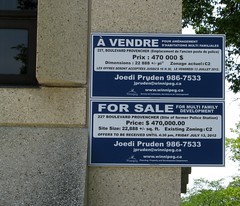




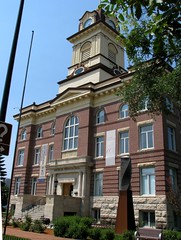
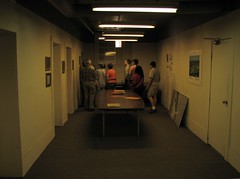
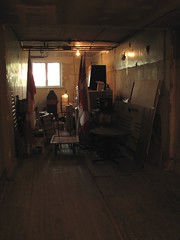
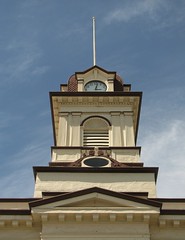

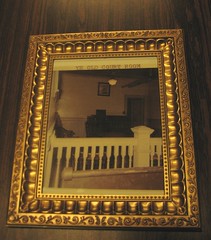
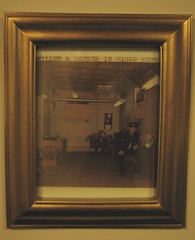

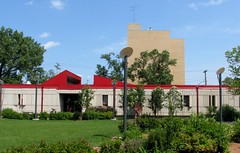
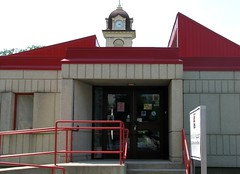

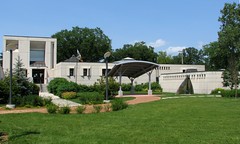

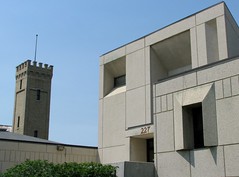



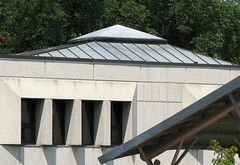
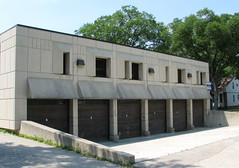




6 comments:
Gaboury also designed the Winnipeg Remand Centre, although not very well. It is a beautiful building from the outside, but the function inside as a jail is terrible and not well thought out.
Man, you researched the shit outta that guy.
Anon 1: That's interesting about the Reman. Someone at the city told me that the St. B jail / justice building was always very high maintenance and not the most practical police station ont he inside.
Anon 2: I usually have to dig back through a lot of newspaper articles etc. to do the research. I hate not including stuff that I have found so, yeah, the research gets detailed if there's lots of stuff in the archives !
Thanks for commenting !
Kinda wild that they want almost half a mill for the property and you have to pay for demolishing; I wonder how big the lot is?
I like Gaboury's work usually but this one does not look like a real prize to me and it's hard to see a new use for it (although that really depends on the structure/layout).
Looking at the map in their bid sheet, it seems as if it is both the police station and court building that are both up for sale / demo as a package.
You're right, though. A pretty price.
Dalila, I'd actually argue that this one - especially the three buildings together in concert - is one of the real gems of Gaboury's practice and demonstrates his development as an architect more than any other building. I don't know why this building would be harder to repurpose in terms of its interior than most. It seems a really great site for offices; the Festival building stands right next door a model of how one might begin said repurposing. Also, as was quoted in the linked article, while I'm all for added density, there are so many empty or near empty lots in the area (including on the river north of Provencher) that this seems like a really bad idea.
Post a Comment